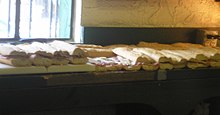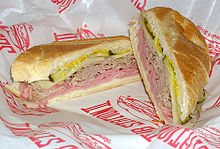Cuban sandwich

A Cuban sandwich is a variation of a ham and cheese originally created by Cuban workers, either in Cuba or in the immigrant community of Ybor City in Tampa Florida.[1][2] Later, Cubans brought it to other communities in southern Florida, particularly Key West and Miami[3] where it is very popular. The sandwich is made with ham, roasted pork, Swiss cheese, pickles, mustard, and sometimes salami[2] on Cuban bread.[1]
History
As with Cuban bread, the origin of the Cuban sandwich (sometimes called a "mixto sandwich", or "Cuban Pressed Sandwich") is somewhat murky. The sandwich became a common lunch food for workers in both the cigar factories and sugar mills of Cuba and the cigar factories of Ybor City around 1900.[1][4]
At that time, travel between Cuba and Florida was easy, and Cubans frequently sailed back and forth for employment, pleasure, and family visits. Because of this blending of culture and ideas, it’s impossible to say where the Cuban sandwich first became a common worker’s meal.[1] By around 1910, however, workers’ cafés in both Ybor City and Cuba were serving many such sandwiches daily.[5][6][7]
The Cuban sandwich was served in kiosks, coffee bars and casual restaurants throughout Cuba, especially in the big cities such as Havana or Santiago de Cuba. Years later, Miami also gained a resident Cuban population. By the 1960's, Cuban sandwiches were common on Miami cafeteria and restaurant menus, and are still very popular there today.[4]
During the 1960's and 1970's, Puerto Rico received its own large influx of Cuban immigrants and the "Sandwich Cubano", which was already known, became a staple at the local cafeterias and lunch wagons.
Ingredients

While there is some debate as to the contents of a “true” Cuban sandwich, most are generally agreed upon. The traditional Cuban sandwich starts with Cuban bread. The loaf is sliced into lengths of 8-12 inches (20-30 cm), lightly buttered on the crust, and cut in half horizontally. A coat of yellow mustard is spread on the bread. Then roast pork, glazed ham, Swiss cheese, and thinly-sliced dill pickles are added in layers. Sometimes the pork is marinated in mojo and slow roasted.
The main regional disagreement about the sandwich’s recipe is whether or not to include salami. In Tampa, Genoa salami[2] is traditionally layered in with the other meats, probably due to influence of Italian immigrants who lived side-by-side with Cubans and Spaniards in Ybor City.[5][8] In Miami, salami is left out.
In Key West, mayonnaise, lettuce, and tomato are usually added. These additions are often available in restaurants in Tampa and Miami, but are frowned upon by traditionalists there.[8][9]
When assembled, the sandwich is lightly toasted in a sandwich press called a plancha, which is only somewhat similar to a panini press but without grooved surfaces. A traditional Cuban sandwich is never made with a panini grill. The plancha both heats and compresses the sandwich, which remains in the press until the bread is crispy and the cheese is melted. It is usually cut into diagonal halves before serving.
Related dishes
The Cuban sandwich triggered a "sandwich craze" in Cuba that lasted several decades, and slowly several types of sandwiches emerged. A very similar and popular sandwich is the medianoche or "midnight" sandwich, so named because of the sandwich's popularity as a staple served in Havan's night clubs right around or after midnight. It is smaller in size and contains the same ingredients as a Cuban sandwich, minus the glazed ham, and made on a softer bread made from a sweet yellow egg dough, similar to challah.
Other sandwiches are "pan con lechon" (pork shoulder sandwich) "pan con chorizo" (Spanish sausage sandwich) "pan con bistec" (sirloin steak sandwich with lettuce, tomato, mayonnaise and julienne fries) and the Frita a Cuban style hamburger, made with ground beef and chorizo, fried onions, a tomato based sauce and topped with very fine julienne fries, all inside the bun. The frita continues to be popular in Miami.
Another unusual Cuban sandwich is the "Elena Ruz". Elena Ruz was a young society debutante in 1930's who would stop at El Carmelo, a popular restaurant and confectionary shop in Havana after an evening at the opera or a social function, and would ask the waiter if he would fix her a sandwich to her orders. It is prepared on white or Cuban bread, with a layer cream cheese on one slice, a layer of strawberry jam or preserves on the other, and thin slices of turkey breast in between. [10]
After the Castro Communist Revolution in 1959, the sandwiches were taken to the Cuban exile communities in New York, Miami, Chicago, Union City, New Jersey, and Puerto Rico.
References and Bibliography
- ^ a b c d Andrew Huse. "Welcome to Cuban Sandwich City". Cigar City Magazine, Volume 1, Issue 2.
- ^ a b c Three Guys From Miami (undated). "Sandwich Cubano / Cuban Sandwich". iCuban website.
{{cite web}}: Check date values in:|date=(help) - ^ Linda Stradley (© 2004). "History of Cuban Sandwich, Cubano Sandwich". What's Cooking America website.
{{cite web}}: Check date values in:|date=(help) - ^ a b Enrique Fernandez (9 August 2007). "Our search for a good Cuban sandwich takes a surprising turn". The Miami Herald.
{{cite web}}: Check date values in:|date=(help) - ^ a b Steve Otto (24 October 2007). "Cuban Is Ours, Any Way You Try To Slice It". The Tampa Tribune.
{{cite web}}: Check date values in:|date=(help) - ^ "Cuban Bread: A History". Bread-Maker website.
- ^ Sara Kennedy (14 August 2002). "Viva El Cubano". Creative Loafing Tampa.
{{cite web}}: Check date values in:|date=(help) - ^ a b Thomas C. Tobin (18 January 2003). "To each, his own sandwich". St. Petersburg Times.
{{cite web}}: Check date values in:|date=(help) - ^ Adam Rugg (11 August 2006). "Tampa Cuban Quest: La Teresita". Eat Foo.
{{cite web}}: Check date values in:|date=(help) - ^ http://www.tasteofcuba.com/cubanturkeysandwich.html
This dish and its origin are also mentioned in:
- Lastra, Frank, Ybor City : The Making of a Landmark Town. University of Tampa Press. 2006.
- Pacheo, Ferdie. Ybor City Chronicles: A Memoir. University of Florida Press. 1994.
External links
- "Cuban Sandwich Recipe". Taste of Cuba. undated.
{{cite web}}: Check date values in:|date=(help) - Michael Segers (1999). "Hot Pressed Cuban, Hold the Dinosaur".
- Barry Popik (29 July 2006). "Cuban Sandwich; Medianoche Sandwich". Historical notes 1901-1966.
{{cite web}}: Check date values in:|date=(help) - Off The Broiler Weblog (30 November 2006). "Florida Dining: Latin American Cafeteria Restaurant".
{{cite web}}: Check date values in:|date=(help) - Off The Broiler Weblog (8 January 2007). "Florida Dining: The Cuban Sandwich Shop".
{{cite web}}: Check date values in:|date=(help) - Off The Broiler Weblog (2 June 2007). "Do It Yourself Cubanos".
{{cite web}}: Check date values in:|date=(help)
